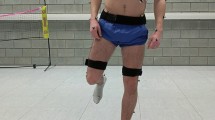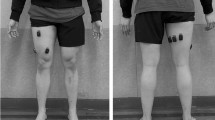Abstract
Purpose
The purpose of this study was to compare the effects of squat training with different depths on lower limb muscle volumes.
Methods
Seventeen males were randomly assigned to a full squat training group (FST, n = 8) or half squat training group (HST, n = 9). They completed 10 weeks (2 days per week) of squat training. The muscle volumes (by magnetic resonance imaging) of the knee extensor, hamstring, adductor, and gluteus maximus muscles and the one repetition maximum (1RM) of full and half squats were measured before and after training.
Results
The relative increase in 1RM of full squat was significantly greater in FST (31.8 ± 14.9%) than in HST (11.3 ± 8.6%) (p = 0.003), whereas there was no difference in the relative increase in 1RM of half squat between FST (24.2 ± 7.1%) and HST (32.0 ± 12.1%) (p = 0.132). The volumes of knee extensor muscles significantly increased by 4.9 ± 2.6% in FST (p < 0.001) and 4.6 ± 3.1% in HST (p = 0.003), whereas that of rectus femoris and hamstring muscles did not change in either group. The volumes of adductor and gluteus maximus muscles significantly increased in FST (6.2 ± 2.6% and 6.7 ± 3.5%) and HST (2.7 ± 3.1% and 2.2 ± 2.6%). In addition, relative increases in adductor (p = 0.026) and gluteus maximus (p = 0.008) muscle volumes were significantly greater in FST than in HST.
Conclusion
The results suggest that full squat training is more effective for developing the lower limb muscles excluding the rectus femoris and hamstring muscles.




Similar content being viewed by others
Abbreviations
- ANOVA:
-
Analysis of variance
- BFl:
-
Biceps femoris long head muscle
- BFs:
-
Biceps femoris short head muscle
- EF:
-
Effect size
- FST:
-
Full squat training
- HST:
-
Half squat training
- SD:
-
Standard deviation
- SM:
-
Semimembranosus muscle
- ST:
-
Semitendinosus muscle
- 1RM:
-
One repetition maximum
- RF:
-
Rectus femoris muscle
- VI:
-
Vastus intermedius muscle
- VL:
-
Vastus lateralis muscle
- VM:
-
Vastus medialis muscle
References
Akima H, Ushiyama J, Kubo J, Fukuoka H, Kanehisa H, Fukunaga T (2007) Effect of unloading on muscle volume with and without resistance training. Acta Astronaut 60:728–736
Berg HE, Tedner B, Tesch PA (1993) Changes in lower limb muscle cross-sectional area and tissue fluid volume after transition from standing to supine. Acta Physiol Scand 148:379–385
Bloomquist K, Langberg H, Karlsen S, Madsgaard S, Boesen M, Raastad T (2013) Effect of range of motion in heavy load squatting on muscle and tendon adaptations. Eur J Appl Physiol 113:2133–2142
Bryanton MA, Kennedy MD, Carey JP, Chiu LZF (2012) Effect of squat depth and barbell load on relative muscular effort in squatting. J Strength Cond Res 26:2820–2828
Caterisano A, Moss RF, Pellinger TK, Woodruff K, Lewis VC, Booth W, Khadra T (2002) The effect of back squat depth on the EMG activity of 4 superficial hip and thigh muscles. J Strength Cond Res 16:428–432
Contreras B, Vigotsky AD, Schoenfeld BJ, Beardsley C, Cronin J (2016) A comparison of gluteus maximus, biceps femoris, and vastus lateralis electromyography amplitude in the parallel, full, and front squat variations in resistance-trained females. J Appl Biomech 32:16–22
da Silva JJ, Schoenfeld BJ, Marchetti PN, Pecoraro SL, Greve JMD, Marchetti PH (2017) Msucle activation differs between partial and full back squat exercise with external load equated. J Strength Cond Res 31:1688–1693
Dostal WF, Soderberg GL, Andrews JG (1986) Actions of hip muscles. Phys Ther 66:351–361
Ebben WP (2009) Hamstring activation during lower body resistance training exercises. Int J Sports Physiol Perform 4:84–96
Ema R, Wakahara T, Kanehisa H, Kawakami Y (2014) Inferior muscularity of the rectus femoris to vasti in varsity oarsmen. Int J Sports Med 35:293–297
Fukashiro S, Komi PV (1987) Joint moment and mechanical power flow of the lower limb during vertical jump. Int J Sports Med 8(suppl):15–21
Fukunaga T, Miyatani M, Tachi M, Kouzaki M, Kawakami Y, Kanehisa H (2001) Muscle volume is a major determinant of joint torque in humans. Acta Physiol Scand 172:249–255
Gorsuch J, Long J, Miller K, Primeau K, Rutledge S, Sossong A, Durocher JJ (2013) The effect of squat depth on multiarticular muscle activation in collegiate cross-country runners. J Strength Cond Res 27:2619–2625
Ikebukuro T, Kubo K, Okada J, Yata H, Tsunoda N (2011) The relationship between muscle thickness in the lower limbs and competition performance in weightlifters and sprinters. Jpn J Phys Fit Sports Med 60:401–411 (in Japanese with English abstract)
Kanehisa H, Ikegawa S, Fukunaga T (1998) Body composition and cross-sectional areas of limb lean tissues in Olympic weight lifters. Scand J Med Sci Sports 8:271–278
Komi PV, Salonen M, Jarvinen M, Kokko O (1987) In vivo measurements of achilles tendon forces in man. I. Methodological development. Int J Sports Med 8:3–8
Mayhew JL, Johnson BD, LaMonte MJ, Lauber D, Kemmler W (2008) Accuracy of prediction equations for determining one repetition maximum bench press in women before and after resistance training. J Strength Cond Res 22:1570–1577
McCaw ST, Melrose DR (1999) Stance width and bar load effects on leg muscle activity during the parallel squat. Med Sci Sports Exerc 31:428–436
McMahon GE, Morse CI, Burden A, Winwood K, Onambele GL (2014) Impact of range of motion during ecologically valid resistance training protocols on muscle size, subcutaneous fat, and strength. J Strength Cond Res 28:245–255
Paoli A, Marcolin G, Petrone N (2009) The effect of stance width on the electromyographical activity of eight superficial thigh muscles during back squat with different bar loads. J Strength Cond Res 23:246–250
Ploutz-Snyder LL, Convertino VA, Dudley GA (1995) Resistance exercise-induced fluid shifts: change in active muscle size and plasma volume. Am J Physiol 269:R536–R543
Pressel T, Lengsfeld M (1998) Functions of hip joint muscles. Med Eng Phys 20:50–56
Ratamess NA, Alvar BA, Evetoch TK, Housh TJ, Kibler WB, Kraemer WJ et al (2009) American college of sports medicine position stand. Progression models in resistance training for healthy adults. Med Sci Sports Exerc 41:687–708
Schott J, McCully K, Rutherford OM (1995) The role of metabolites in strength training II. Short versus long isometric contractions. Eur J Appl Physiol 71:337–341
Simonsen EB, Thomsen L, Klausen K (1985) Activity of mono- and biarticular leg muscles during sprint running. Eur J Appl Physiol 54:524–532
Sugisaki N, Kurokawa S, Okada J, Kanehisa H (2014) Difference in the recruitment of hip and knee muscles between back squat and plyometric squat jump. PLoS One 9:e101203
Watanabe N, Enomoto Y, Ohyama K, Kano Y, Yasui T, Miyashita K, Kuno S, Katsuta S (2000) Relationship between hip strength and sprint performance in sprinters. Jpn J Phys Educ Health Sport Sci 45:520–529 (in Japanese with English abstract)
Watanabe K, Katayama K, Ishida K, Akima H (2009) Electromyographic analysis of hip adductor muscles during incremental fatiguing pedaling exercise. Eur J Appl Physiol 106:815–825
Weiss LW, Fry AC, Wood LE, Relyea GE, Melton C (2000) Comparative effects of deep versus shallow squat and leg-press training on vertical jumping ability and related factors. J Strength Cond Res 14:241–247
Wiemann K, Tidow G (1995) Relative activity of hip and knee extensors in sprinting-implications for training. New Study Athl 10:29–49
Wright GA, DeLong TH, Gehlsen G (1999) Electromyographic activity of the hamstrings during performance of the leg curl, stiff-leg deadlift, and back squat movements. J Strength Cond Res 13:168–174
Acknowledgements
This study was supported by a Grant-in-Aid for Scientific Research (B) (17H02149 to K. Kubo) from the Japan Society for the Promotion of Science. The authors thank Mr. Sasaki S. (Hanada College) for his technical assistance with magnetic resonance imaging measurements.
Author information
Authors and Affiliations
Contributions
All authors approved to submit this manuscript. The contributions of all authors were as follows: KK: conception of this study, acquisition of data, drafting the manuscript; TI: acquisition of data, analysis data; HY: drafting figures and tables, conception of this study.
Corresponding author
Ethics declarations
Conflict of interest
I have no conflict of interest with this work.
Additional information
Communicated by William J. Kraemer.
Publisher's Note
Springer Nature remains neutral with regard to jurisdictional claims in published maps and institutional affiliations.
Rights and permissions
About this article
Cite this article
Kubo, K., Ikebukuro, T. & Yata, H. Effects of squat training with different depths on lower limb muscle volumes. Eur J Appl Physiol 119, 1933–1942 (2019). https://doi.org/10.1007/s00421-019-04181-y
Received:
Accepted:
Published:
Issue Date:
DOI: https://doi.org/10.1007/s00421-019-04181-y




